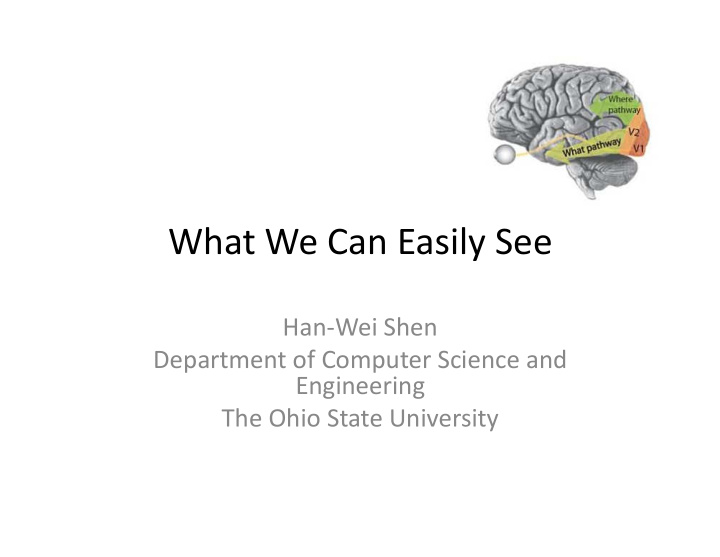



What We Can Easily See Han-Wei Shen Department of Computer Science and Engineering The Ohio State University
Mo@va@on • How am I going to aCract people’s aCen@on to my – Web page – Product brochure – Marke@ng pamphlet • Design is the key • The key to a good design is to understand how people think visually
Mo@va@on • Purpose of this lecture – What makes a graphic symbol to be found rapidly – How something can be highlighted • We want to ensure all visual queries can be effec@vely and rapidly served – Make sure meaningful graphic objects in a design have the right amount of salience – Visual queries should be supported with the most visually dis@nct objects
How do we see the world? • Do you feel you can see the world vividly, in complete detail? • We comprehend the world by constantly moving our eyes • Something is easier to find than others – Blinking light – Bright red sweater in a crowd of people wearing black Ehklhfdiyaioryweklblkhockxlyhirhupwerlkhlkuyxoiasysifdh lksajdhflkihqdaklljerlajesljselusdslRsalsuslcjlsdsjaf;ljulaRluj oufojrtopjhklghqlkshlkRlkdshflymcvciwoazlsiUrmckreieuid
How do we see the world? • Do you feel you can see the world vividly, in complete detail? • We comprehend the world by constantly moving our eyes • Something is easier to find than others – Blinking light – Bright red sweater in a crowd of people wearing black What about finding ‘q’ and why it is difficult? Ehklhfdiyaioryweklblkhockxlyhirhupwerlkhlkuyxoiasysifdh lksajdhflkihqdaklljerlajesljselusdslRsalsuslcjlsdsjaf;ljulaRluj oufojrtopjhklghqlkshlkRlkdshflymcvciwoazlsiUrmckreieuid
Low Level Machinery
Low Level Machinery • Primary visual cortex (V1) has cells that would fire (emi\ng a series of spikes of electrical current) when certain kind of paCerns are put in front of eyes • Different areas are processing different type of informa@on – Color, shape, texture, mo@on, stereoscopic depth • This informa@on is passed to visual area 2 (V2) – Millions of fibers from the eye send info to billions of neurons in V1 and then V2
What and Where • What and Where pathways – What pathway: processing informa@on about the iden@ty of an object – Where pathway: processing informa@on about where the objects in the world are located
Eye Movement Planning • How do the eyes get directed to the right loca@on when we are looking for something? • Bias compe@@on – Neurons which process the type of info that we are looking for can shout louder • Color, orienta@on, size, mo@on, etc – Other cells keep quiet • The biased responses are sent up the what pathway, and up the where pathway to make eye movements.
What Stands Out? • Something you cannot miss even if you try
Pre-aCen@ve • The @me to respond did not depend on the number of distracters – This suggests a parallel automa@c process • The effects measured by this method were pre-aCen@ve – Automa@c mechanisms opera@ng prior to the ac@on of aCen@on • Pop-out effects are stronger when a single target differs from all other objects where all other objects are iden@cal • It is the degree of feature-level contrast between an object and its surroundings that makes it dis@nct. • Common features are color, orienta@on, size, mo@on, stereoscopic depth – a striking correspondence to the early processing mechanisms.
What paCerns do not show pop-out? • Visual conjunc@ve search is hard – Finding green squares • Features easy to see are done by neurons in the boCom of the visual processing. Hard to see features are done by neurons farther up the what pathway
Sufficient Differences • For things to pop out, the low level feature differences need to be sufficiently large – 30 degree difference or more • The extend of varia@on in the background is also important – Extremely homogeneous vs. busy background
Examples
Examples
Feature Channels • Channels are defined by the different ways the visual image is processed in V1 • Learning does not help
Lesson for Design • If you want to make something easy to find, make it different from its surroundings according to some primary visual channel – Color, size, shape, blinking, and so on • How to make several things easy to search at the same @me? – Use different channels – GDP example
Lesson for Design • Use mul@ple channels will make a symbol even easier to find – Differ in both size and color will make it easier • Crea@ng a display containing more than 8 to 10 independently searchable symbols is impossible – not enough channels • We have only about three different steps in each channel – 3 sizes, 3 orienta@ons, etc • Visibility enhancements are not symmetric – Increase the size is more dis@nc@ve than decrease in size
Mo@on • Mo@on is extremely powerful • Things that emerge into the visual field is more powerful than things that simply move • Think of example of email alert • Rapid mo@on vs. slower and smoother mo@on – Urgent or gentle reminder • Don’t overuse because it can be irrita@ng – Because people cannot suppress it
The Visual Search Process • Move and scan loop • Eye movement control loop • PaCern tes@ng loop
Mul@-scale structure for design • To support efficient visual search, a design should be given large-scale as well as small-scale structure • This allows our eyes to move to the likely neighborhood of a target, then the local paCern informa@on provides a few candidates for individual detail eye fixa@on
Conclusion • Visual search is something that is fundamental to almost all seeing • There is a world of difference between something that can be located in a single eye movement and one that takes five or ten • Use pop-out proper@es well can go a long way
Reference • Visual Thinking for Design by Colin Ware
Recommend
More recommend